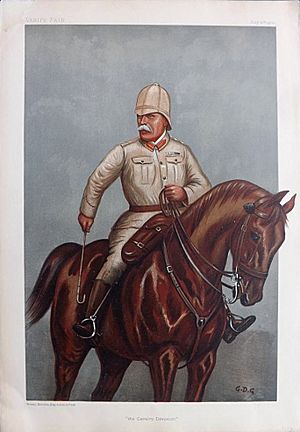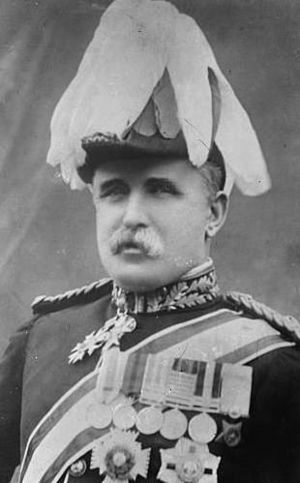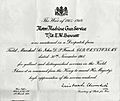John French, 1st Earl of Ypres facts for kids
Quick facts for kids
The Earl of Ypres
|
|
|---|---|

Photograph of John French, 1st Earl of Ypres, Commander-in-Chief
|
|
| Born | 28 September 1852 Ripple, Kent, England |
| Died | 22 May 1925 (aged 72) Deal, Kent, England |
| Buried |
Ripple, Kent
|
| Allegiance | United Kingdom |
| Service/ |
|
| Years of service | 1866–1921 |
| Rank | Field Marshal |
| Unit |
|
| Commands held |
|
| Battles/wars | |
| Awards | |
| Relations | Charlotte Despard (sister) |
Field Marshal John Denton Pinkstone French, 1st Earl of Ypres (born 28 September 1852 – died 22 May 1925), was a very important British Army officer. He was known as Sir John French for many years. He was born in Kent, England, into an Anglo-Irish family.
French first served briefly in the Royal Navy as a midshipman. Later, he joined the cavalry in the British Army. He quickly rose through the ranks and showed his skills during the Nile Expedition.
He became a national hero during the Second Boer War in South Africa. He led troops in important battles and helped relieve besieged cities. After the war, he held several high-ranking positions in the British Army.
His most important role was leading the British Expeditionary Force (BEF) at the start of the First World War. He commanded the BEF for about a year and a half. Later, he became the Commander-in-Chief of Home Forces in Britain. He also served as Lord Lieutenant of Ireland during the Irish War of Independence.
Early Life and Military Start
John French joined the Royal Navy in 1866. He trained on ships like HMS Britannia. He became a midshipman, which is a junior officer.
He served on HMS Warrior patrolling the English Channel. He saw the accidental sinking of HMS Captain. French left the Navy in 1870. He found he had a fear of heights and often got seasick.
Starting in the Army
In 1870, French joined the Suffolk Artillery Militia. He then became a lieutenant in the 8th King's Royal Irish Hussars in 1874. Soon after, he moved to the 19th Hussars. This was a less expensive regiment.
He was stationed at Aldershot Command. There, he became a skilled hunter and horse rider. In 1876, his regiment moved to Ireland. He quickly rose to the rank of captain in 1880. By 1883, he was a major. These were fast promotions for a young officer.
Fighting in Sudan
In 1884, French joined the Nile Expedition in Sudan. This mission aimed to rescue Major-General Charles George Gordon. French was second-in-command of the cavalry. They traveled across a vast desert.
His cavalry unit mostly did reconnaissance. They also fended off attacks from Dervish fighters. After the Battle of Abu Klea, French led a small group protecting the rear. He impressed his senior officers. He was promoted to lieutenant colonel in 1885. This was another very early promotion for him.
A Career Saved
French's career almost ended in the 1890s. He had some financial problems. But powerful friends in the army helped him. These friends included General Redvers Buller and General Evelyn Wood.
He became commander of the 2nd Cavalry Brigade in 1897. Then, he led the 1st Cavalry Brigade at Aldershot in 1899. He was promoted to temporary major-general. Around this time, he borrowed money from Douglas Haig. This loan saved him from financial ruin.
Second Boer War Hero
Arriving in South Africa
French sailed to South Africa for the Second Boer War in September 1899. He expected to lead a cavalry brigade. He arrived in Ladysmith just as fighting began.
Battle of Elandslaagte
On his first day, French was ordered to check on Boer forces near Elandslaagte. He led a mixed force of cavalry and infantry. On 21 October, he attacked the Boers.
The battle was a success for the British. British cavalry even charged with lances. This was seen as proof that old-fashioned cavalry charges still worked. French celebrated this small victory for the rest of his life.
Soon, the British forces had to retreat to Ladysmith. The Boers then began a siege of the town. French and Haig managed to escape on the last train out. The Boers tore up the tracks minutes later.
Operations in Cape Colony
French was then sent to the Cape Colony. He commanded forces in the Colesberg area. He had about 2,000 men, outnumbered by the Boers. But he managed to keep the initiative. He prevented a Boer invasion of the Cape.
His actions were praised by many. The Times History called his operations an "almost unbroken series of successes." He showed great skill in tactics.
Relieving Kimberley
French was one of the few senior officers kept by the new Commander-in-Chief, Lord Roberts. Roberts ordered French to relieve the besieged city of Kimberley. French promised to reach Kimberley in five days.
His Cavalry Division had to travel across dry land. They faced many challenges, including lack of water. At Klip Drift, French's cavalry charged Boer positions. This charge was seen as a brilliant move. French entered Kimberley on 15 February. He was congratulated by Roberts and Queen Victoria. He was promoted to major-general.
Later War Actions
French continued to play a key role. He helped pursue the Boer general Piet Cronje at Paardeberg. He also took part in the advance on Bloemfontein and Pretoria.
He was involved in the victory at Diamond Hill. French also led operations against Boer guerrilla forces. In August 1900, he led a daring move through mountains. This led to the capture of Barberton, an important Boer supply base.
The war seemed to be ending. French was promoted to major-general.
Under Lord Kitchener
When Lord Kitchener took command, French was given the Johannesburg Area. He had to fight against Boer guerrillas. French believed strong measures would end the war faster.
He was appointed a Knight Commander of the Order of the Bath. This was for his service in the war. French and Kitchener had some disagreements. But Kitchener praised French's willingness to take responsibility. He also noted French's bold and confident nature.
The war ended in June 1902. French returned home to a hero's welcome. He received many honors.
Between the Wars
Leading at Aldershot
French was promoted to lieutenant-general in 1902. He became Commander of the 1st Army Corps at Aldershot Command. Many saw him as a top soldier.
He believed that the Army's main strike force should be ready for overseas service. French also pushed for new artillery. He also thought an enemy would find it hard to invade Britain.
Inspector-General of the Army
In 1907, French became the Inspector-General of the Army. He was also made a Knight Grand Cross of the Royal Victorian Order. He did not support conscription. He thought a volunteer army would be enough.
French was very interested in trenches, machine guns, and artillery. He also believed in strict training for soldiers. He traveled to inspect troops in the Far East and Canada.
During this time, he had a disagreement with Horace Smith-Dorrien. Smith-Dorrien was his successor at Aldershot. They had different ideas about army training and soldier welfare.
Chief of the Imperial General Staff
In 1912, French became the Chief of the Imperial General Staff (CIGS). This made him the professional head of the British Army. His goal was to get the Army ready for war.
He worked closely with Henry Wilson. Wilson became his most trusted advisor. French was promoted to field marshal in 1913.
The Curragh Incident
In 1914, there was a crisis over Irish Home Rule. Some officers threatened to resign if the army was used against Ulster Protestants. French tried to resolve the situation.
He agreed to a written statement. This statement said the army would not be used to force Home Rule on Ulster. But the Prime Minister, H. H. Asquith, publicly rejected parts of this statement. French felt he had to resign in April 1914.
Commander-in-Chief of the BEF
Going to War in 1914
When World War I began in July 1914, French was chosen to command the British Expeditionary Force (BEF). This was Britain's main army sent to France. He was briefly re-appointed Inspector-General first.
French met with French military leaders. His orders were to work with the French army. But he was also told to avoid too many losses. The BEF was small compared to the French army.
Clash with General Lanrezac
French met General Charles Lanrezac, who commanded the French Fifth Army. They had a difficult meeting. They struggled to understand each other. French spoke little French, and Lanrezac spoke no English.
French was concerned about German movements. He also had fewer divisions than planned. This led to a poor relationship between the two generals.
Battle of Mons
French's friend, General Grierson, died suddenly. Lord Kitchener appointed Horace Smith-Dorrien to command II Corps. French disliked Smith-Dorrien.
The BEF faced strong German forces at the Battle of Mons. French initially thought the attacks were small. But he soon realized the Germans were much stronger. He ordered his troops to retreat.
The Great Retreat
Battle of Le Cateau
The BEF continued to retreat. On 26 August, Smith-Dorrien decided to stand and fight at Le Cateau. His troops were exhausted. French was initially angry. But he gave Smith-Dorrien permission to decide how to retreat.
The battle was fierce. French and his staff thought the BEF had suffered huge losses. French later criticized Smith-Dorrien's actions. However, many historians now believe the stand at Le Cateau helped the BEF. It allowed them to reorganize and continue their retreat.
Meeting with Kitchener
French decided the BEF needed to pull back far behind the front lines. He wanted to rest and resupply his troops. Lord Kitchener was concerned. He traveled to France to meet French.
The meeting was tense. French was angry that Kitchener wore his Field Marshal's uniform. French felt Kitchener was trying to show he was superior. But French agreed to keep the BEF in the line. He promised to cooperate with the French.
Battle of the Marne
French agreed to join the First Battle of the Marne. This was a major Allied counterattack. French's troops advanced slowly. They were exhausted from the long retreat.
The BEF's advance helped create a gap between German armies. This had a big effect on the battle. The Germans were forced to retreat. The battle saved Paris.
Autumn Battles
After the Marne, the war became a Race to the Sea. Both sides tried to outflank each other. French wanted the BEF to move to the coast. This would allow them to work with the Royal Navy.
French also worried about shell shortages. He pushed for more machine guns and heavy artillery. He was concerned about German artillery superiority.
First Battle of Ypres
The First Battle of Ypres was a very tough fight. French initially thought the Germans were running out of men. But the BEF faced strong German attacks. The battle was very costly.
The original BEF was almost destroyed. French was disturbed by the heavy losses. He was reluctant to send experienced officers home.
Loos and Resignation
Planning the Loos Offensive
French and Joffre planned new attacks on the Western Front. French believed these attacks were needed to help Russia. He also hoped to break the German front.
The Battle of Loos was planned for September 1915. French decided to keep a large reserve force. He wanted to use them on the second day of the battle.
Battle of Loos
On the first day of the attack (25 September), poison gas was used. But the wind blew it back into British lines. This caused many British casualties. One British division broke through German defenses.
However, French had placed his reserves too far back. They could not reach the front line in time. By the next morning, the Germans had strengthened their positions. The attack on the second day resulted in huge British losses.
The Battle of Loos was a failure. French was heavily criticized for his slow release of reserves. Many officers lost confidence in him.
French's Resignation
The King and other leaders believed French was no longer fit to command. French was asked to resign. He was offered a peerage and a new job. This was Commander-in-Chief Home Forces.
French resigned on 6 December 1915. Douglas Haig replaced him as commander of the BEF. French was cheered by his old regiment as he left France.
Commander-in-Chief, Home Forces
Defending Britain
French returned to England in December 1915. He was made Commander-in-Chief of the British Home Forces. In 1916, he became Viscount French of Ypres.
He believed an invasion of Britain was unlikely. He focused on inspecting defenses. He wanted to fight any invasion on the coast.
Easter Rising in Ireland
In 1916, the Easter Rising occurred in Ireland. This was an armed rebellion. French sent troops to Ireland to help put it down. He also selected General Maxwell to take command there. The rebellion was quickly crushed.
Later Years and Advice
French became critical of Haig's offensives on the Western Front. He believed they were too costly. He also took on responsibility for air defense in Britain. He pushed for more anti-aircraft guns and fighter planes.
In 1917, French advised the War Cabinet. He argued that Haig's estimates of German losses were too high. He suggested a defensive strategy on the Western Front. This was until American forces arrived.
Lord Lieutenant of Ireland
Serving in Ireland
In May 1918, French became Lord Lieutenant of Ireland. This was a very important position. He aimed to stop violence and bring about Home Rule.
He ordered the arrest of Sinn Féin leaders. He believed they had little support from most Irish people. He also tried to improve the police force.
Challenges in Ireland
French faced many challenges. The Irish War of Independence was ongoing. He wanted more troops to keep order. He also supported recruiting new police officers. These included the "Black and Tans" and the Auxiliary Division.
He resigned as Lord Lieutenant of Ireland in April 1921.
Later Life and Death
French retired from the British Army in April 1921. In 1922, he was made the Earl of Ypres.
He wrote his memoirs, 1914, in 1919. The book caused some controversy. Many people, including Haig, said it contained inaccuracies.
French died from cancer at Deal Castle on 22 May 1925. He was 72 years old. His funeral was held at Westminster Abbey. Many important military figures attended. His ashes were buried in Ripple, Kent.
Honors and Memorials
British Honors
- Viscount French (1916)
- Earl of Ypres (1922)
- Knight of the Order of St Patrick (1917)
- Knight Grand Cross of the Order of the Bath (1909)
- Member of the Order of Merit (1914)
- Knight Grand Cross of the Royal Victorian Order (1907)
- Knight Commander of the Order of St Michael and St George (1902)
- Member of the Privy Council (1918)
Other Honors
- Knight 1st class Order of the Red Eagle of Prussia (1902)
- Croix de guerre of France (1916)
- Grand Cordon of the Order of Leopold of Belgium (1916)
- Order of St. George of Russia, 3rd Class (1916)
- Grand Cross of the Order of Saints Maurice and Lazarus of Italy (1917)
- First Class of the Order of the Star of Karađorđe of Serbia (1918)
- Grand Cordon of the Order of the Rising Sun of Japan (1918)
Memorials
John French is remembered with memorials. These are in Ypres Cathedral and Canterbury Cathedral.
Images for kids
-
Official notice of "mentioned in dispatches" by French for a soldier in the Motor Machine Gun Service for gallantry at the Battle of Neuve Chapelle. Signed by Churchill who was Secretary of State for War in 1919 when the citation was issued.
-
John French, 1st Earl of Ypres c. 1919 by John Singer Sargent
-
Deal Castle at the end of the 19th century; at the rear are the Captain's Quarters, where French died in 1925 and which were destroyed in 1943
See also
 In Spanish: John French para niños
In Spanish: John French para niños












